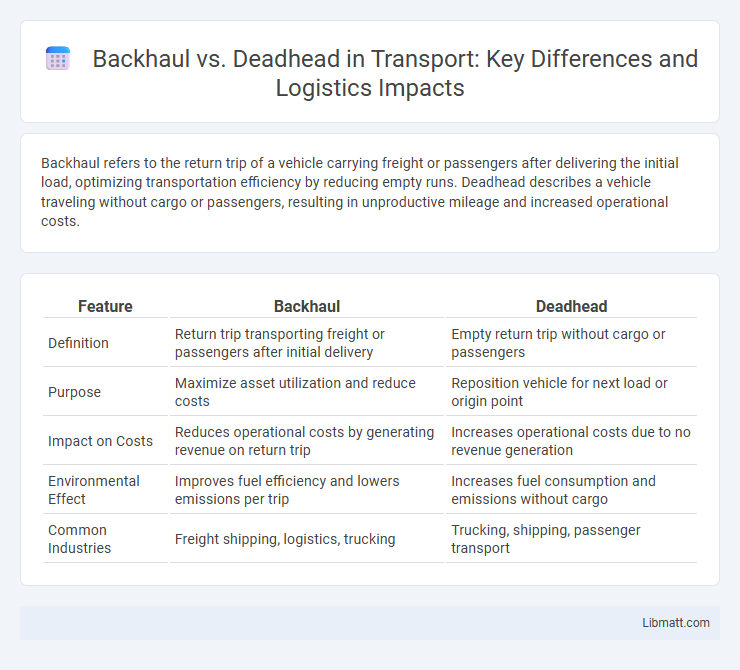Backhaul refers to the return trip of a vehicle carrying freight or passengers after delivering the initial load, optimizing transportation efficiency by reducing empty runs. Deadhead describes a vehicle traveling without cargo or passengers, resulting in unproductive mileage and increased operational costs.
Table of Comparison
| Feature | Backhaul | Deadhead |
|---|---|---|
| Definition | Return trip transporting freight or passengers after initial delivery | Empty return trip without cargo or passengers |
| Purpose | Maximize asset utilization and reduce costs | Reposition vehicle for next load or origin point |
| Impact on Costs | Reduces operational costs by generating revenue on return trip | Increases operational costs due to no revenue generation |
| Environmental Effect | Improves fuel efficiency and lowers emissions per trip | Increases fuel consumption and emissions without cargo |
| Common Industries | Freight shipping, logistics, trucking | Trucking, shipping, passenger transport |
Introduction to Backhaul and Deadhead
Backhaul refers to the return trip a truck makes after delivering a shipment, often with cargo to maximize efficiency and reduce costs. Deadhead describes when a truck travels without any freight, resulting in wasted fuel and increased operational expenses. Understanding the difference helps you optimize logistics and improve your transportation management strategy.
Defining Backhaul in Transportation
Backhaul in transportation refers to the return trip of a commercial vehicle, transporting goods back to its original point or another destination after completing the primary delivery. This process optimizes logistics by reducing empty miles, thereby improving fuel efficiency and decreasing operational costs. Effective management of backhaul routes enhances asset utilization and supports sustainable transportation practices.
What is Deadhead in Logistics?
Deadhead in logistics refers to the trip when a truck or transport vehicle moves without carrying any freight, often returning empty after delivering goods. This non-revenue movement increases operational costs and reduces efficiency by consuming fuel and driver hours without generating income. Understanding your deadhead rates is essential for optimizing routes and improving overall supply chain profitability.
Key Differences Between Backhaul and Deadhead
Backhaul refers to the return trip of a freight vehicle carrying cargo from the original delivery point back to its base or another location with load, optimizing transportation efficiency. Deadhead describes the empty return journey when the vehicle travels without any cargo, resulting in wasted fuel and increased operational costs. Understanding these key differences helps you reduce expenses and improve logistics performance by minimizing deadhead miles and maximizing backhaul opportunities.
Operational Impacts of Backhaul and Deadhead
Backhaul improves operational efficiency by generating revenue on return trips, reducing empty miles and optimizing fleet utilization. Deadhead trips result in increased fuel consumption, higher operational costs, and reduced driver productivity due to non-revenue travel. Your logistics strategy benefits from minimizing deadhead miles to enhance overall supply chain performance and profitability.
Cost Implications: Backhaul vs Deadhead
Backhaul significantly reduces transportation costs by generating revenue on return trips, optimizing fuel usage and vehicle capacity. Deadhead trips increase expenses as trucks travel empty, incurring fuel, labor, and maintenance costs without income. Understanding your logistics strategy can help minimize deadhead mileage, improving overall cost efficiency and profitability in freight operations.
Environmental Considerations
Backhaul operations reduce carbon emissions by maximizing freight capacity on return trips, lowering fuel consumption and minimizing empty mileage. Deadhead occurs when trucks travel empty, contributing to increased greenhouse gas emissions and inefficient resource use. Optimizing logistics to increase backhaul frequency supports sustainable transportation and decreases overall environmental impact.
Strategies to Minimize Deadheading
Minimizing deadheading is crucial for improving transportation efficiency and reducing costs in logistics operations. Strategies include optimizing route planning using advanced GPS and real-time traffic data, consolidating loads to ensure trucks return with cargo, and leveraging backhaul opportunities where carriers find freight for return trips. Implementing these techniques helps you maximize asset utilization and decrease empty miles, boosting overall profitability.
Maximizing Backhaul Opportunities
Maximizing backhaul opportunities involves efficiently matching return trips with freight loads to reduce empty miles and increase revenue. Optimizing route planning and leveraging transportation management systems (TMS) helps carriers identify potential backhaul routes, minimizing deadhead miles that generate no income. Effective backhaul utilization enhances fleet productivity and lowers operational costs by ensuring trucks are consistently carrying cargo in both directions.
Conclusion: Optimizing Freight Efficiency
Backhaul and deadhead are critical concepts in freight logistics that directly impact operational efficiency and cost management. By strategically planning backhaul routes, freight carriers can maximize truck utilization and reduce empty miles, whereas minimizing deadhead trips prevents unnecessary fuel consumption and labor expenses. Your ability to optimize backhaul opportunities while avoiding deadhead occurrences significantly enhances overall freight efficiency and profitability.
backhaul vs deadhead Infographic

 libmatt.com
libmatt.com